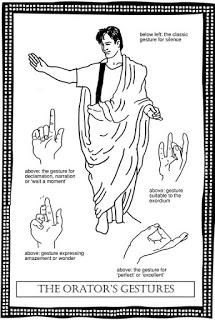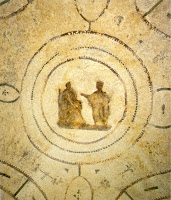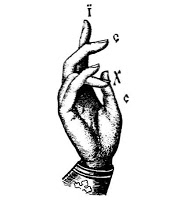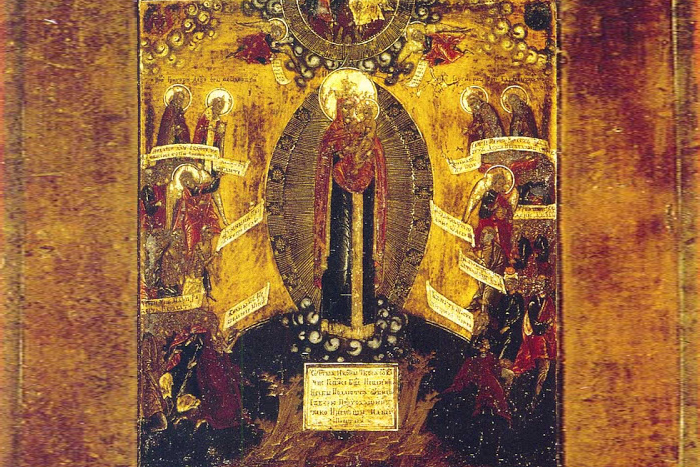
Origin of the hand gestures

In ancient Greece and Rome, there was a well-established system of hand-gestures used in oratory and rhetoric. Some of the oldest surviving Orthodox icons are found in Rome, and so it is believed that the first Orthodox iconographers may have co-opted these hand gestures when depicting Christ, His Saints, and the Angels. For example, in icons of the Annunciation, the Archangel Gabriel is shown with hand raised in the way which in the ancient world signified the beginning of an important oration. This can be seen in the oldest surviving Annunciation icon, and the hymns of the feast recall both Gabriel’s the important news he gave to Mary, so the hand-gesture is fitting.

This oratory meaning is probably the original “source” of showing Christ raising His hand, as more than anyone else He has something important to say. However, to any Orthodox or Catholic Christian, Jesus’ right hand in Icons is unmistakably shown as being raised to give a blessing. The arrangement of the hand is repeated by clergy when blessing others and so the Saints in icons, if they were clergy, often hold their right hand in the same way. This has a symbolism all of its own which has developed over time, and is worth investigating.
Symbolism of the Blessing

The fingers spell out “IC XC”, a widely used four letter abbreviation of the Greek for Jesus (IHCOYC) Christ (XPICTOC). It is by the name of Jesus that we are saved and receive blessings: “At the name of Jesus every knee should bow, of things in heaven, and things in earth, and things under the earth;” (Phil 2:10).

The three fingers of Christ – as well as spelling out “I” and “X” – confess the Tri-unity of God: Father, Son and Holy Spirit. The touching finger and thumb of Jesus not only spell out “C”, but attest to the Incarnation: to the joining of divine and human natures found in the body of Jesus Christ.
Similarities with Buddhist Iconography
The above meanings are worth emphasizing because otherwise there can be some confusion, or even scandal, caused by similar images of the Buddha holding his hands in a very stylized way. In response to this there are a few things which need to be considered:
§ Given the well-established use of hand-gestures in ancient Greek and Roman oratory explained above, and the geographical location of Christ’s Incarnation and the early Christian Church, it is far more likely that the hand gestures were “borrowed” by Christians from the Roman senate than the disciples of Buddha.
§ There is meaning behind the way Christ holds His hand in Icons; there is meaning behind the way Buddha holds his hands in statues: but there the similarity ends. The symbolic hand gestures of Buddha are called mudras, and whilst they are rich in their own meaning, they are not communicating the same faith as Icons of Christ. If we rejected every medium for conveying Truth just because another religion uses the same medium then we’d be left with nothing! We must accept the similarities and discern the differences.
§ Just because a religion was around before Christ was born, doesn’t mean that all its teachings predate Christianity. Of the common Buddhist Mudras, the Vitarka Mudra is the one which most resembles Christ’s right hand in icons. Yet the earliest representations of the vitarka mudra show the three fingers straight, rather than curved. Much later we see images, which look remarkably like Christian iconography. Yet the image is from the 8th century A.D., centuries after the iconography of Christ is established. We can be forgiven for questioning just exactly which religion is influencing the other.
§ Finally, the Buddhist mudras are didactic; they are hand gestures designed to convey a message. Yet the “IC XC” Christogram is much more than this: it is both a sign and means of blessing. A statue of the Buddha holds his hands just so and his devotees are supposed to remember a certain teaching; Christ raises His right hand and Christians receive the blessings of God. More than this, even if His servants, the Saints, holds their hands in the same way, we are assured of receiving the blessings of God, through the name of Jesus Christ.
Take a look at the hand-painted icons of Christ the Pantocrator





This is a very interesting and informative article. The chart of the Greek and Roman hand gestures used in oratory and how that relates to the icon of the Annunciation is fascinating. It's like how in the book of Acts the Apostle Paul stretched out his hand to speak to the mob. The explanation of the exact hand gesture of Christ blessing that every priest uses, is so helpful.
Wow! The connection between Buddhist and Christian iconography would actually be to do with the fact that both originate in classical art. The Bactrian kingdom in modern southern Afghanistan and Pakistan was a hellenic culture with a heritage that went back to Alexander the Great. Buddhist figurative art comes from this classical source. There are even depictions of the Buddha meditating with the protection of the classical hero Heracles/Hercules. Classical heritage is not a “western” phenomenon by any means.
What is completely missed in these musings is any understanding that hand gestures can be spontaneous physical manifestations of a spiritual awakening. Once this is experienced oneself it becomes obvious that similarities in the hand gestures depicted in images and statutes of Christ and the Buddha and indeed other spiritual figures would be expected as they are all enlightened or spiritually awake.
Thank you 🙏
Archangel Gabriel’s raised hand seen in icons of the Annunciation is a gesture of submission and humility. The Mother of God is praised in countless hymns and prayers as more honourable and more glorious than all creation, even the angels in heaven. Gabriel knows this, and is showing his deference to the woman who will conceive, give birth to, and nurse and nurture God Incarnate. This is a major theme in the hymns and prayers read, chanted and sung at the Annunciation services. In some Annunciation icons, the Mother of God also raises her hand, palm outwards, signifying her humility and obedience to the will of God: “Let it be to me according to Your will.”
The raised hand with palm outward is also seen in icons of countless saints, again expressing humility, obedience to God, and renunciation of what is worldly in their path to sanctity.
This is nothing short of a circumvention of Truth that the Early Christian Church post Apostles truly deviated from Scriptures and incorporated syncretism by borrowing these symbolisms from Pagan Rome or Babylon and Eastern Paganism such as Hinduism and Buddhism which do not confess the same God of the Bible!